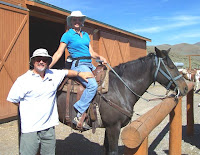Today, our report is from Golden Gate Park in San Francisco, home of the new California Academy of Sciences. It's "an aquarium, a planetarium, a natural history museum, and a four-story rainforest all under one roof ," according to their PR department.
For gardeners, here is what I learned:
Butterflies like pretty flowers, especially if they are inside a $488 million rainforest dome.
Here is what else I learned:
According to this picture, zombie dinosaurs are threatening to eat all our plants. And, there is a serious shortage of butts.
And who knew that South Africa had amorous penguins?
Here is an actual conversation with a California Academy of Sciences docent at the South African Penguin Exhibit:
Me: Do you adjust the environment in that enclosure to give the penguins "seasons"?
Docent: Yes, we turn down the temperature at night.
Me: But more than that, do you attempt to replicate seasonal changes to reflect the environment in South Africa?
Docent: Yes, we give them more light now because it is summer in South Africa.
Me: I think it's winter there.
Docent: Oh.
Me: Do you know if the caretakers reduce the intensity or angle of the light on a seasonal basis?
Docent: See those three penguins on the rock? Two of them are females, they are sisters, and they are battling over the other one, a male. I have seen him mating with both of them. His name is Brendan. It's a regular soap opera!
Me: Thank you.




























